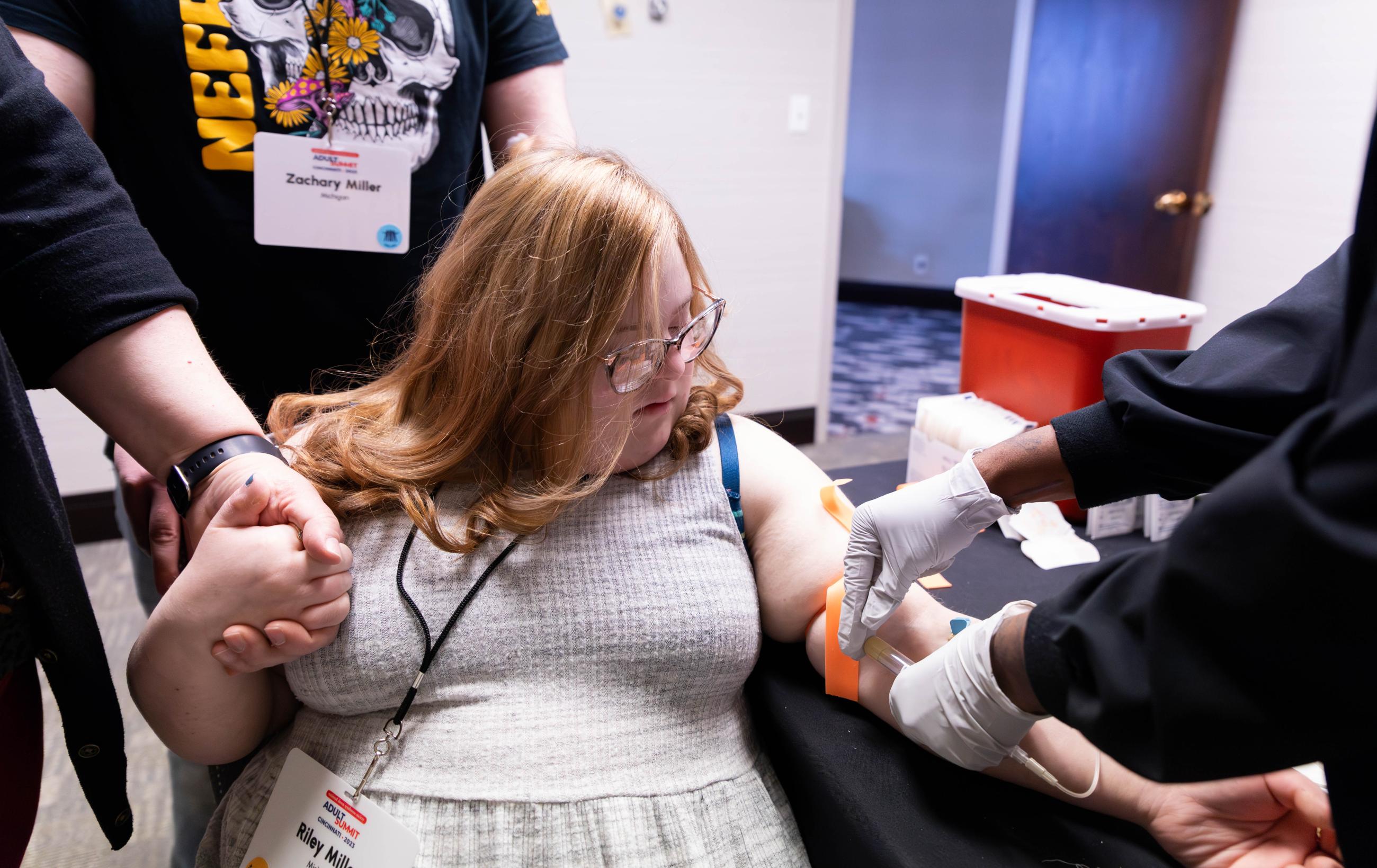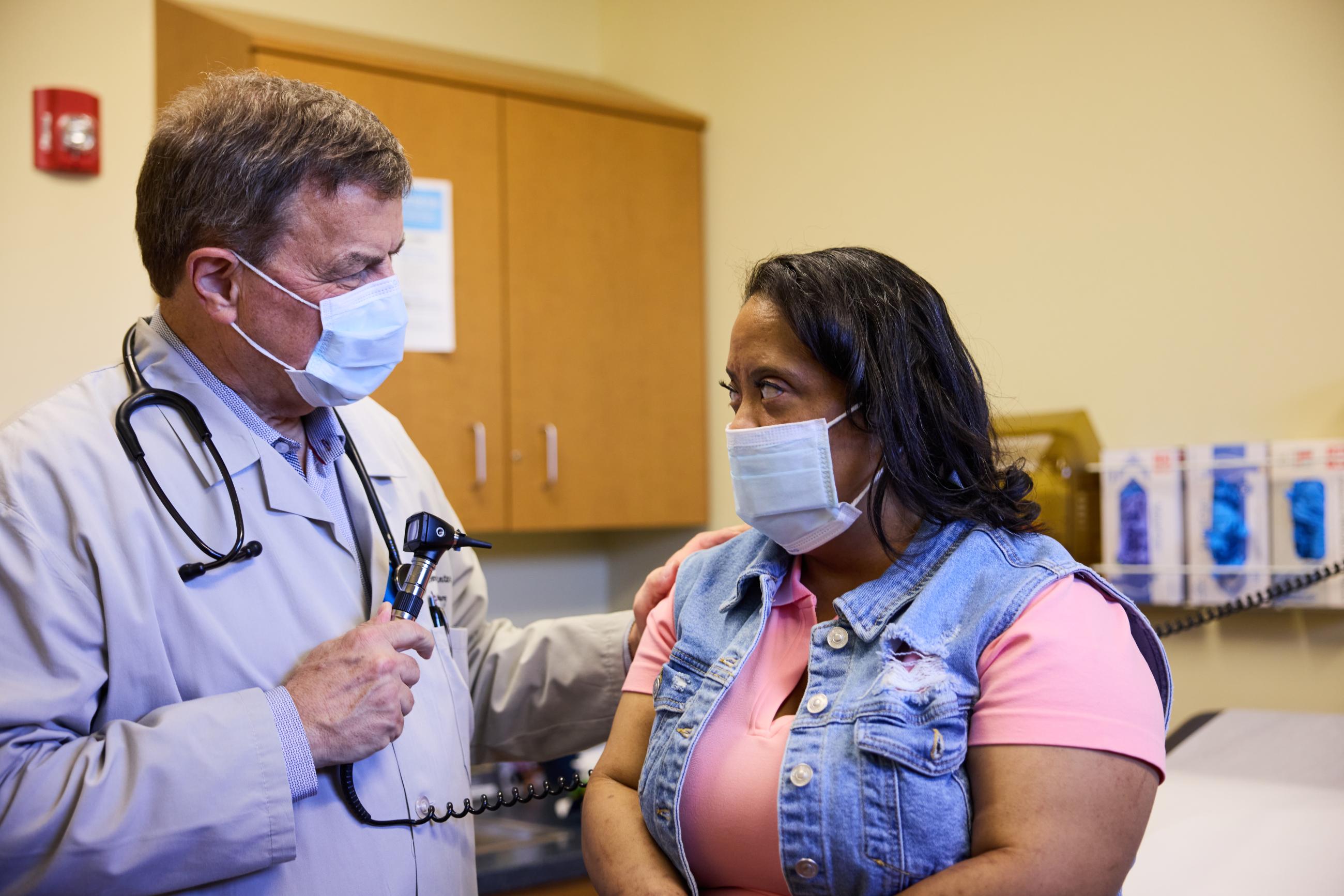
Women’s health is a vast area of health with many unique considerations that can impact daily life. Despite the importance of women’s health, women with Down syndrome receive substantially less gynecological healthcare compared to women without Down syndrome, although both populations share many of the same concerns. By learning more about the various aspects of women’s health, women with Down syndrome and their caregivers can increase their preparedness for these health concerns throughout the lifespan.
Seeing a Doctor

Gynecological healthcare refers to seeing a doctor who will conduct various assessments. These assessments can be conducted by a gynecologist, or in some cases, a primary healthcare provider. A visit to the women’s health provider usually consists of three parts: discussion, pelvic exam, and breast exam. It is important to discuss your and your loved one’s comfort levels with each part of the exam with the care team. Together, you can decide how to best conduct the assessments and/or if they are necessary for each visit.
Discussion
The discussion portion of your loved one’s visit will typically consist of questions from the doctor and any questions or concerns you may have for the doctor.
At the beginning of the visit, the doctor may ask questions about your loved one’s medical history, their family’s medical history, menstrual cycle, and sexual activity. You or your loved one may also want to ask questions about birth control, period management, vaginal health (itching, discomfort, or discharge), or any other concerns.
Questions the doctor may ask your loved one before a pelvic or breast exam:
- When was your last period?
- How often do you have periods?
- How long do your periods last?
- Do you have any unusual pain, itching, or discharge from your vagina or vulva?
- Are you sexually active?
- Are you using birth control?
People with Down syndrome are often concrete and literal thinkers. This means abstract thinking and answering questions about abstract concepts like appetite, time, and pain may be difficult for women with Down syndrome to answer. You can help your loved one prepare for more abstract questions like “When was your last period?” by supporting them with the use of a calendar or a period tracking app to make the dates of their period more concrete.
Self-advocacy among individuals with Down syndrome is important because it can enhance your loved one’s feeling of dignity and strengthen their independence. You can help your loved one feel empowered to advocate for themselves during their healthcare appointments by preparing their questions, concerns, and preferences for the appointment with a worksheet. To learn more about self-advocacy for individuals with Down syndrome during healthcare visits, please refer to the Self-Advocacy at Medical Appointments webpage.
Pelvic Exams
Pelvic exams are a physical examination of the health of reproductive organs. The exam reviews the vulva, vagina, cervix, uterus, fallopian tubes, ovaries, and rectum for disease or infection. There are no formal guidelines on when women with Down syndrome should begin receiving pelvic exams. In general, pelvic exams are recommended for women based on their medical history or symptoms (The American College of Obstetricians and Gynecologists, 2018). Talk with your provider to see if a pelvic exam should be considered for your loved one with Down syndrome. The exam usually starts with a check of the outside of the genitals (vulva) to look for anything unusual. Then, a tool called a speculum is gently inserted into the vagina to open it, so the healthcare providers can see the cervix and check for any problems. The exam may also include a Pap smear to screen for cervical cancer or for a human papillomavirus (HPV) test. The exam will also require the provider to insert one or two gloved fingers into the vagina and press on the lower stomach with the other hand to check for lumps and the health of the uterus and ovaries (National Cancer Institute, n.d.).
Pelvic exams can be difficult for some women with Down syndrome to tolerate. You can support your loved one to prepare for pelvic exams by reviewing materials that detail the process with images and descriptions. Additionally, your loved one may be more comfortable with you or another female relative, caregiver, or nursing staff in the room during the exam.
Changes can be made to help make pelvic exams more comfortable for women with Down syndrome. Refer to the Primary Care Provider’s Guide to Women’s Health and Down Syndrome for additional tips on how to make a pelvic exam more comfortable for your loved one.
Breast Exam
During a clinical breast exam, a healthcare provider will examine the breasts for any changes or abnormalities, like a lump (Susan G. Komen, 2025). There are no specific recommendations for when women with Down syndrome should begin receiving breast exams. Talk to your provider to see if a breast exam should be considered for your loved one. The exam will consist of a healthcare provider carefully feeling the breasts, underarms, and just below the collarbone for lumps or any other changes. The healthcare provider may also visually check the breasts while the patient is sitting up and physically examine the breasts while the patient is lying down. If any changes or problems are found, your loved one’s healthcare provider may suggest follow-up tests like a mammogram or a breast ultrasound.
Similar to a pelvic exam, your loved one may feel more comfortable with you or another female relative, caregiver, or nursing staff in the room during the exam.
Cancer
Women with Down syndrome are at a decreased risk for most solid tumor cancers, including cervical and breast cancer. Cervical cancer is less common in all women with intellectual disabilities, and breast cancer is specifically less common in women with Down syndrome.
Cervical Cancer
Risk factors for cervical cancer include HPV infection, having a weakened immune system, and smoking (National Cancer Institute, 2024). Women with Down syndrome have a low overall risk of cervical cancer. However, people with intellectual and developmental disabilities (IDD) are at risk of sexual abuse seven times more than people without disabilities, which increases their potential exposure to HPV and cervical cancer. Screening for cervical cancer is recommended for women between 21 and 65 years old, regardless of sexual activity, and consists of pap smears and HPV testing. There are no formal cervical cancer screening guidelines for women with Down syndrome. Talk with your provider about the best approach for your loved one with Down syndrome.
Prevention for cervical cancer includes receiving the HPV vaccine. HPV is a sexually transmitted disease that can lead to cervical cancer. Women with Down syndrome can be exposed to HPV through consensual sexual activity or through sexual abuse. Since women with Down syndrome are at an increased risk of sexual abuse, talk to your provider to see if the HPV vaccine should be considered for your loved one.
Breast Cancer
Risk factors for breast cancer include older age, family history of breast or ovarian cancer, reproductive history resulting in greater exposure to estrogen, exposure to radiation therapy, obesity, and alcohol consumption (National Cancer Institute, 2025). In the general population, screening is generally recommended beginning at age 40 for a mammogram every other year. However, given the overall low risk of breast cancer, women with Down syndrome often choose not to undergo screening. There are no formal guidelines for breast cancer screening in women with Down syndrome, and there is no data on how family history may impact a woman with Down syndrome’s breast cancer risk.
Menstruation
Menstruation, also known as a period, is when blood and tissue is discharged from the uterine lining and leaves the body through the vagina (National Institute of Child Health and Human Development, n.d.). Most adolescents get their first period around age 12, and for teens with Down syndrome, it usually happens around the same time or a little earlier.
Menstrual Health Education & Management
Discussions about sexuality and development, including menstrual education, are often delayed or skipped among adolescents with IDD. Menstrual health education can increase self-esteem, confidence, and reproductive self-agency among adolescents with IDD, including Down syndrome (Randall et al., 2024). Methods of managing period hygiene include utilizing visual supports like a social story, creating a schedule with reminders, keeping a period kit to take into the restroom, and using alternative menstrual hygiene products like pads without wings or period underwear. Period kits were found to stimulate positive family discussions about menstruation and improve adolescents’ menstruation-related knowledge. An example period kit could include the menstrual hygiene product of choice (pads, tampons, period underwear, etc.), a social story with visual supports, and symptoms management options. In a recent study about menstrual care, parents of women with IDD reported that a novel social story and period underwear were the most useful resources from a period kit (Boxerman et al., 2025).
Heavy or Painful Periods
Heavy or painful periods are common in the general population and appear to be as common in women with Down syndrome. Heavy or painful periods can be associated with cramping, nausea, vomiting, food cravings, and breast tenderness. Women with Down syndrome may express their discomfort with behavior changes, like irritability, around the time of menstruation. Treatment options for painful periods can include non-steroidal anti-inflammatory drugs (NSAIDs), hormonal medications, and exercising or applying heat. If you are concerned about these symptoms, talk to a provider to learn more about potential treatment options for your loved one.
Period Suppression
Period suppression is a medically safe practice to stop or lessen menstruation with the use of hormonal medications. This can be a helpful option for some women with Down syndrome who are having a hard time managing their periods or dealing with the discomfort. Talk to your provider about expectations for period management and the risks and benefits of hormonal medications before initiating period suppression.
Premenstrual Syndrome and Premenstrual Dysphoric Disorder
Premenstrual syndrome (PMS) and premenstrual dysphoric disorder (PMDD) appear to be as common in women with Down syndrome as they are in the general population. PMS symptoms occur the five days before menstruation and can include both mood and physical symptoms, such as angry outbursts, anxiety, confusion, depression, irritability, social withdrawal, abdominal bloating, breast tenderness or swelling, headache, joint or muscle pain, swelling of extremities, or weight gain. PMDD is a severe form of PMS. Treatment options for PMS and PMDD can include the use of hormonal medications or selective serotonin reuptake inhibitors (SSRIs). If you are concerned about symptoms your loved one may be experiencing, reach out to a healthcare provider for more information and potential treatment options.
Menopause
Menopause is a normal part of aging for women and is when periods stop. Women with Down syndrome tend to experience menopause younger than the general population, between ages 44 and 46.

Menopausal Symptoms
Menopausal symptoms include loss of bladder control, problems with sleep, vaginal dryness, and mood changes. Women with Down syndrome may have challenges in explaining some of the symptoms they are experiencing, and caregivers may notice menopausal symptoms before the woman with Down syndrome. A visual story example can help women with Down syndrome understand and express menopausal symptoms. In the general population, menopausal symptoms can be treated through hormonal medications or therapy, non-hormonal medications like SSRIs, and over-the-counter products (Office of Women’s Health, 2025). However, these medications have not been studied in women with Down syndrome. Talk to your provider to learn more about potential treatment options for your loved one.
During this transition, women’s bodies begin to use energy differently, the distribution of fat in the body changes, weight gain may occur easily, and they may experience changes in bone density, heart health, or physical function.
Menopause & Memory
A unique relationship between memory difficulties and menopause exists for women with Down syndrome. Some women with Down syndrome may report confusion and memory difficulties as they undergo the menopause transition. This population has a short interval between the age of menopause and the potential onset of dementia. Moreover, early age of menopause and low estrogen levels are associated with an earlier age of onset of dementia.
Additional Considerations

Birth Control
There are various hormonal medications, also known as birth control, to aid in period management and act as a contraceptive. Birth control can help treat painful periods and as a period suppressant. Before selecting a form of birth control talk to your provider about potential risks to women with Down syndrome.
Among the general population, birth control options include oral hormonal contraceptive pills (OCPs), injectable progesterone, levonorgestrel-releasing intrauterine devices (IUDs), implantable devices, and non-progesterone IUDs. However, hormonal contraceptive use has not been studied among women with Down syndrome.
The use of some birth control methods can lead to an increased risk of blood clots. This may not be suitable for women with Down syndrome, who already may be at an increased risk of blood clots. Further, some birth control methods like IUDs or implantable devices may require an in-office procedure, which may create discomfort for women with Down syndrome and be difficult to tolerate. There are also side effects of different types of birth control, like weight fluctuation, elevated blood pressure, loss of bone mineral density, or breakthrough bleeding, that may not be ideal for women with Down syndrome. Ultimately, risks and benefits should be discussed between the patient, caregivers, and healthcare provider to decide what is best for your loved one.
Polycystic Ovarian Syndrome
Polycystic ovarian syndrome (PCOS) is related to a hormonal imbalance, and symptoms include menstrual cycle changes, cardiovascular issues, acne, insulin resistance, and obstructive sleep apnea. The exact cause of PCOS is unknown, but research has shown that genetic and environmental factors contribute to PCOS (National Institute of Child Health and Human Development, n.d.).
PCOS is common among the general population. A study found that PCOS was less common among women with Down syndrome, but because of how common it is in the general population, it is likely that many women with Down syndrome have PCOS.
Women with Down syndrome may experience potential difficulties when seeking a diagnosis for PCOS. During examination, providers may need to confirm the presence of polycystic ovaries, which can only be confirmed by imaging such as transvaginal ultrasound. Transvaginal ultrasounds may be uncomfortable for women with Down syndrome, and sometimes an alternative, like a transabdominal ultrasound, can supply enough information about the health of the ovaries.
There are treatments available for women with PCOS, and the best option depends on whether or not they want to get pregnant. Treatments can include hormonal contraceptives, metformin, or topical treatments for excessive hair growth and acne. If you are concerned about PCOS, talk to your provider about potential treatment options for your loved one.
Sexuality & Pregnancy
Women with Down syndrome are not excluded from romantic relationships or sexual activity. Education about the rights and responsibilities of sexual expression and consent should be encouraged among individuals with Down syndrome. Additionally, having access to sexuality education can help individuals with Down syndrome learn more about STI prevention, setting appropriate boundaries, and consent.
While fertility is lower for women with Down syndrome, it is still possible for them to become pregnant, especially if they are sexually active – and there have been many documented cases of women with Down syndrome having children. Also, women with Down syndrome who are pregnant have an increased risk of premature delivery and adverse neonatal outcomes (Alnoman et al., 2024).
For more information about sexuality in individuals with Down syndrome, please refer to the Relationships & Sexuality webpage.
External Resources
- Advocate Medical Group: Adult Down Syndrome Center offers various social stories, visuals, and additional resources about health and wellbeing for people with Down syndrome.
- Pelvic Exam Social Stories
- Menstruation (Period) Visuals
- Menopause Visuals
References
Alnoman, A., Baghlaf, H. A., Badeghiesh, A. M., Peeva, M., & Dahan, M. H. (2024). Pregnancy, delivery, and neonatal outcomes among women living with Down syndrome: a matched cohort study, utilizing a population database. Archives of Gynecology and Obstetrics, 309(6), 2681–2687. https://doi.org/10.1007/s00404-023-07208-0
Azziz, R., Carmina, E., Dewailly, D., Diamanti-Kandarakis, E., Escobar-Morreale, H. F., Futterweit, W., Janssen, O. E., Legro, R. S., Norman, R. J., Taylor, A. E., & Witchel, S. F. (2009). The Androgen Excess and PCOS Society criteria for the polycystic ovary syndrome: The complete task force report. Fertility and Sterility, 91(2), 456–488. https://doi.org/10.1016/j.fertnstert.2008.06.035
Boxerman, S., Flores, B., Yang, X., Masters, E. M., Crehan, E. T., & French, A. V. (2025). Development and Evaluation of “Period Kits” for Adolescents with Intellectual and Developmental Disabilities: An Embedded Mixed Methods Study. Journal of Pediatric & Adolescent Gynecology, 38(1), 45–51. https://doi.org/10.1016/j.jpag.2024.09.004
Graham, H., Couwenhoven, T., Wilson, L., Welch, S., Capone, G., Chandan, P., Chicoine, B., Krohn, L., & Frank, K. (2024). Primary care provider’s guide to women’s health and Down syndrome. National Down Syndrome Society.
Gülay, A., & Eratay, E. (2024). Perceptions of forensic interviewers on the sexual education of individuals with a disability exposed to sexual victimisation. The Journal of Sexual Aggression, 1–15. https://doi.org/10.1080/13552600.2024.2421184
Krieg, S., Krieg, A., Loosen, S. H., Roderburg, C., & Kostev, K. (2024). Cancer Risk in Patients with Down Syndrome—A Retrospective Cohort Study from Germany. Cancers, 16(6), 1103-. https://doi.org/10.3390/cancers16061103
Lepore-Stevens, M. (2024). Adapting a human sexuality curriculum for students with disabilities. Health Education Journal, 83(8), 841-854. https://doi.org/10.1177/00178969241280442
Molinari, S., Fossati, C., Nicolosi, M. L., Di Marco, S., Faraguna, M. C., Limido, F., Ocello, L., Pellegrinelli, C., Lattuada, M., Gazzarri, A., Lazzerotti, A., Sala, D., Vimercati, C., Capitoli, G., Daolio, C., Biondi, A., Balduzzi, A., & Cattoni, A. (2024). Endocrine, auxological and metabolic profile in children and adolescents with Down syndrome: from infancy to the first steps into adult life. Frontiers in Endocrinology (Lausanne), 15, 1348397-. https://doi.org/10.3389/fendo.2024.1348397
National Cancer Institute. (n.d.) NCI dictionary of cancer terms. Pelvic exam. National Cancer Institute. https://www.cancer.gov/publications/dictionaries/cancer-terms/def/pelvic-exam
National Cancer Institute. (2024). Cervical Cancer Causes, Risk Factors, and Prevention. National Cancer Institute. https://www.cancer.gov/publications/dictionaries/cancer-terms/def/pelvic-exam
National Cancer Institute. (2025). HPV and Cancer. National Cancer Institute. https://www.cancer.gov/publications/dictionaries/cancer-terms/def/pelvic-exam
National Cancer Institute. (2025). Breast Cancer Prevention (PDQ®)–Patient Version. National Cancer Institute. https://www.cancer.gov/publications/dictionaries/cancer-terms/def/pelvic-exam
National Institute of Child Health and Human Development. (n.d.). Menstruation and Menstrual Problems. National Institute of Child Health and Human Development. https://www.nichd.nih.gov/health/topics/factsheets/menstruation
National Institute of Child Health and Human Development. (2024). Polycystic ovary syndrome (PCOS). National Institute of Child Health and Human Development. https://www.nichd.nih.gov/health/topics/factsheets/menstruation
National Institute of Arthritis and Musculoskeletal and Skin Diseases. (2022). Osteoporosis. National Institute of Arthritis and Musculoskeletal and Skin Diseases. https://www.niams.nih.gov/health-topics/osteoporosis
National Institute on Aging. (2024). What is menopause? National Institute on Aging. https://www.nia.nih.gov/health/menopause/what-menopause
Office on Women’s Health (2025). Menopause treatment. Office on Women’s Health. https://womenshealth.gov/menopause/menopause-treatment
Pennsylvania Department of Human Services. (2025). Pelvic exam social story. ASERT. https://paautism.org/resource/pelvic-exam-social-story/
Planned Parenthood. (2025). Wellness Visit. Planned Parenthood Federation of America, Inc. https://www.plannedparenthood.org/learn/health-and-wellness/wellness-visit
Randall, K. N., Hopkins, C. S., & Drew, H. (2024). Menstrual education programs for girls and young women with intellectual and developmental disabilities: A systematic review. Journal of Applied Research in Intellectual Disabilities, 37(4), e13264-n/a. https://doi.org/10.1111/jar.13264
Susan G. Komen. (2025). Clinical breast exam. Susan G. Komen. https://www.komen.org/breast-cancer/screening/clinical-breast-exam/
The American College of Obstetricians and Gynecologists. (2018). The Utility of and Indications for Routine Pelvic Examination. The American College of Obstetricians and Gynecologists. https://www.acog.org/clinical/clinical-guidance/committee-opinion/articles/2018/10/the-utility-of-and-indications-for-routine-pelvic-examination#:~:text=ABSTRACT:%20The%20pelvic%20examination%20has,despite%20evidence%20to%20the%20contrary
Thiyagarajan, D.K., Basit, H., Jeanmonod, R. (2024). Physiology, Menstrual Cycle. In: StatPearls [Internet]. Treasure Island (FL): StatPearls Publishing; 2025 Jan-. Available from: https://www.ncbi.nlm.nih.gov/books/NBK500020







